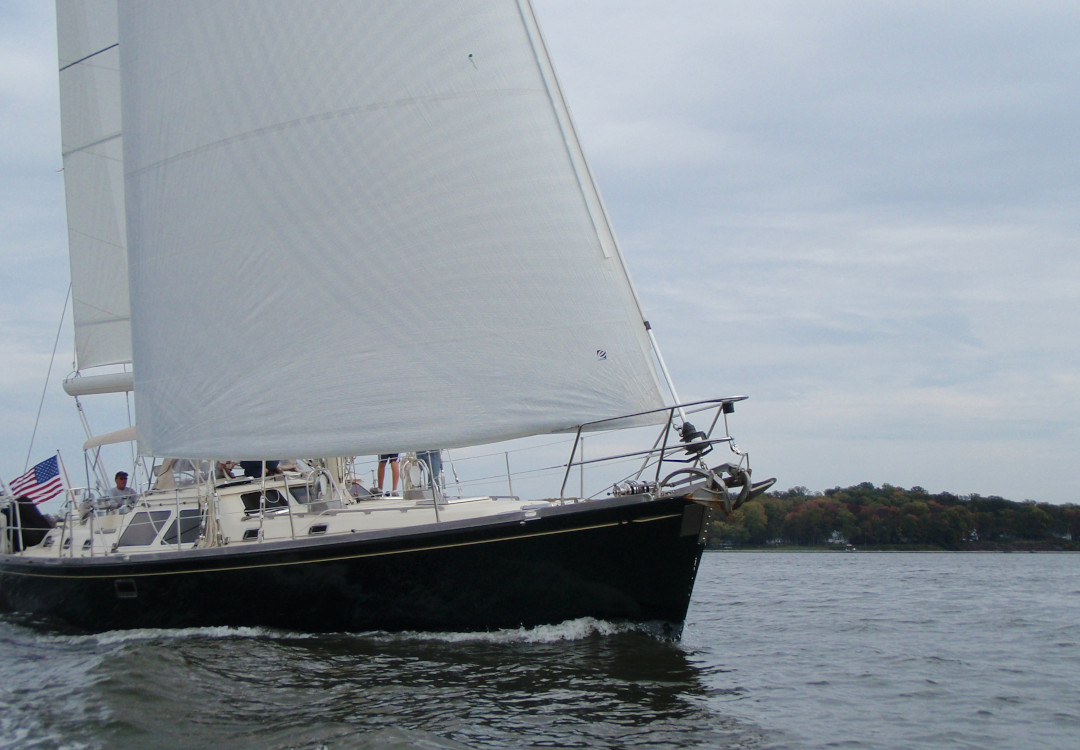Quick Guide for Genoa Sizing
In this article, we’ll take a look at finding the right genoa size for boats with overlapping headsails. If your boat does not have overlapping headsails, head over here (insert link) for more information. To help determine if your boat was designed for overlapping or non-overlapping headsails, click here (insert link)
For Racing
Picking the proper genoa size make all the difference when it comes to speed on the course. Having the correct sail for the conditions will balance the helm and make the boat go faster through the water. Not every boat will have all of these sails, and the maximum size for your headsail can vary depending on how a boat was designed and what the designer intended. Keep in mind that the percentage assigned to each genoa refers to the ‘LP’ measurement of the sail when compared to the boat’s ‘J’ measurement (Read below for more information on these terms). If you have any questions on which sail is best for your boat, feel free to reach out to our team for help (insert contact information)
#1 Genoa – 150-155% (0-15 knots)
The biggest and most powerful sail in the inventory, the #1 Genoa is designed for light and medium-air sailing to get the boat moving. The large sail has a substantial overlap with the mainsail and a deep shape for maximum power. The #1 will also be made from the lightest material of any sail in the inventory to help it fly in lighter breeze. Depending on the vintage of a particular boat, you may see variations including a Light, Medium, or Heavy #1, all of which are generally the same size but with varied shapes and cloth weights.
#2 Genoa – 130%-145% (10-20 knots)
#2 Genoas are versatile sails that cover the mid-range between #1 Genoas and #3 Jibs. #2 Genoas have the most extensive variation in design between boats since they are built to close the gaps between other sails. The sizing of this sail is heavily dependent on rig geometry and sailing conditions. A #2 Genoa will look like a flatter, heavier #1, but it will typically also have slightly less overlap to minimize helm at the upper end of its wind range.
#3 Jib – 95%-105% LP (15-30 knots)
#3 Jibs are the heavy-weather workhorses of the upwind sail inventory. Much smaller, flatter, and heavier than a genoa, a #3 is designed to keep the boat under control and moving when the wind starts howling. The #3 is where genoa-driven boats make the transition to a non-overlapping headsail, meaning its clew will pass neatly in front of the mast while tacking. Not only will it de-power the boat in big breeze, but the #3’s smaller size make it much easier to trim and maneuver.
#4 Jib 80%-95% LP (22 knots plus)
Designed for the days you thought about staying at home, the #4 Jib will make the boat manageable while still being able to power through rough seas. The smallest, strongest, and flattest headsail in the inventory, a #4 keeps the boat flatter and more in-control, as it has a shorter luff-length than a #3 to achieve greater balance in the helm.
Storm Jib
Despite our best efforts, every sailor knows the feeling of getting caught in unavoidable weather. The Storm Jib is the sail to use to get home safety on those days. Storm Jib sizing is generally dictated by the rules of the race or offshore category you’re participating in, but one thing is for sure: their area is a fraction of the size when compared to the rest of the headsails. They are typically built with heavy, orange material that can withstand extreme conditions and be seen over long distances. No sailor expects to use this sail often, but every sailor wants to be prepared when the time comes.
Which sail combination is right for you?
Every boat needs to have a different mix of sails to maximize performance across a range of conditions. Variables like common local conditions, sailing style, and the types of races expected can further change the best-suited sail combination. It is best to define those variable first and then begin choosing sails. Once the expectations are set, the next goal is to determine how many sails are needed for the proper setup. Some boats sail with only one or two distinct headsails, while others may be carrying as many as six or seven.
The goal when choosing the proper headsails is to cover the entire spectrum of expected conditions while minimizing the number of headsails onboard. If you plan to stay close to shore or sail in an area that has a narrow wind range, you can expect to carry only a #1 and #3 to cover most conditions. If you plan to head offshore, you are likely to consider carrying more sails to be prepared in any conditions.
Sailing in a light-air venue like San Diego or Chicago will skew your inventory towards lighter sails, potentially with a Light #1, Heavy #1, and little else. Sailing at a venue like San Francisco where the breeze is always on may see you leaving the #1 at home, instead springing for a #3 and #4.
Our team at 180 Sails is here to work with you and customize each sail to fit your specific needs. The wind ranges you see listed under each sail are merely suggestions and can be fitted to suit any inventory or sailing goals you might have.
LP Percentages explained
The sizing of a Genoa is expressed in an LP (Luff Perpendicular) percentage, commonly given just as a percentage and pronounced as two numbers (150% LP is commonly referred to as a “one-fifty”). The LP is a measurement taken from the clew of a sail to the closest point on the luff, creating a line that is perpendicular to the luff. The LP measurement is divided by the J measurement (link to J meaning) to give you the percentage of a given headsail. For example, a boat with a J length of 10 and a genoa with an LP of 15, the sail would measure as a 150% LP genoa (15 divided by 10 equals 1.5 or 150%).
If you have a boat with overlapping headsails (designed for use of a genoa) the LP ran range from 80% (even lower for some storm sails) up to 155%. Though rare, some boats were even designed for genoas in the 165%-175% range.
For boats designed with non-overlapping headsails, the LP percentage will top-out between 100% and 115% depending on the geometry of the rig and sweep of the spreaders.


